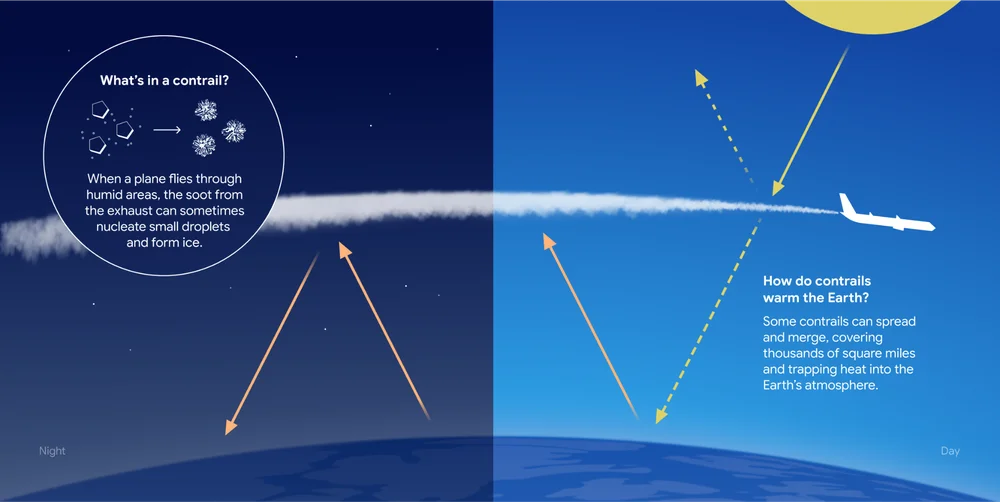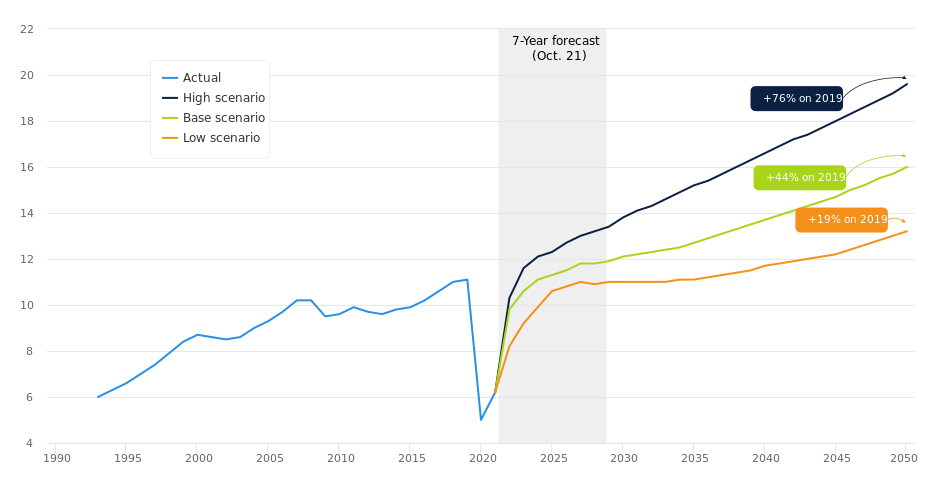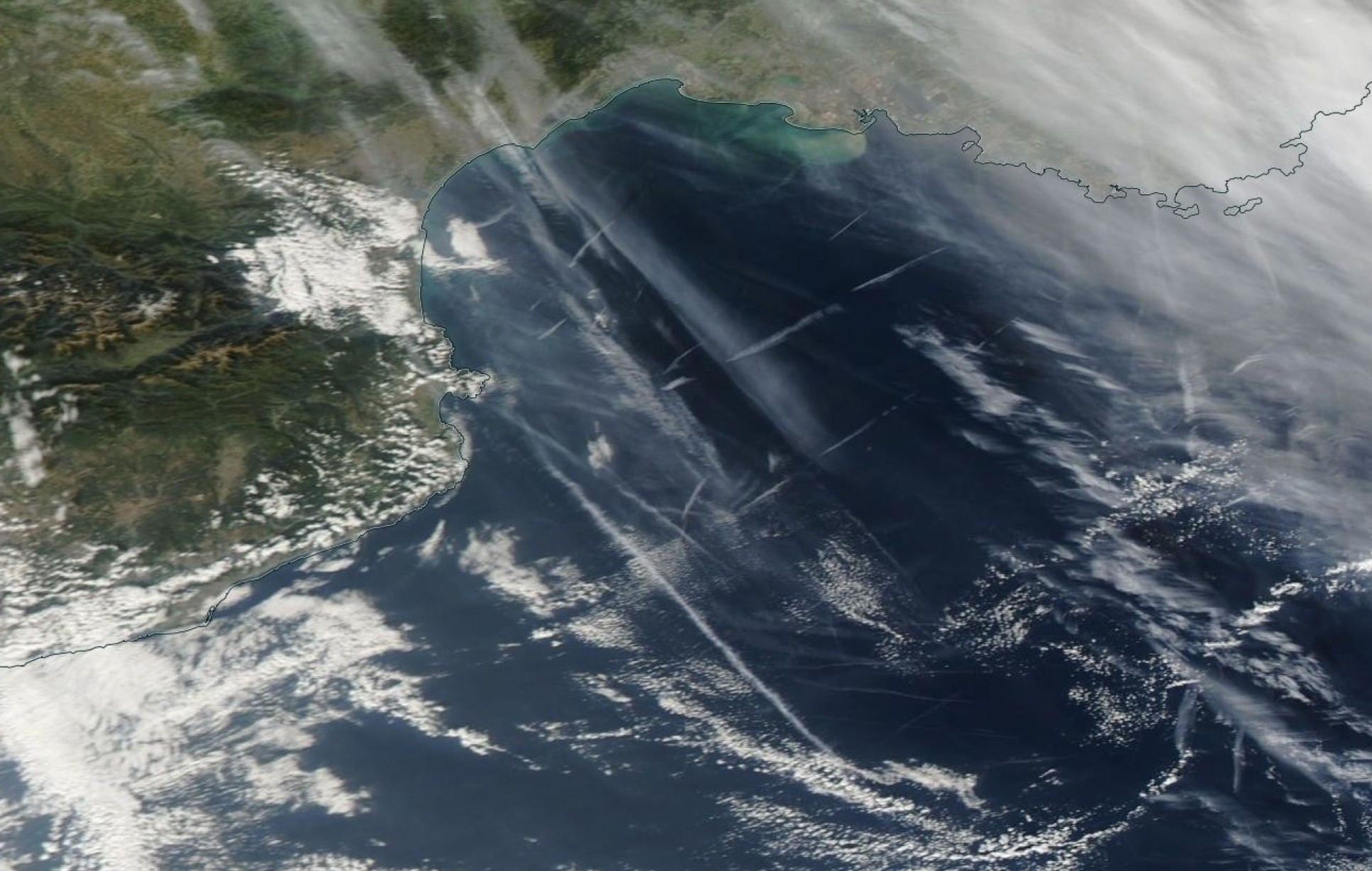Aviation and Contrails
Contrails, short for “condensation trails,” are a fascinating and often overlooked phenomenon that significantly impacts aviation and the environment.

These visible streaks of cloud-like formations (as in the above image) often trail behind aircraft in the sky and are called “contrails”. The challenge lies in distinguishing these contrails from natural cirrus clouds. [1] As we explore the intricate relationship between contrails and climate change, it becomes evident that these seemingly harmless trails play a substantial role in shaping our planet’s climate system.

As the aviation industry continues to expand, the proliferation of contrails raises pertinent questions about their contribution to climate change. The aviation industry, a vital global sector with immense economic and environmental implications, has continued to expand its reach over the years. The “Aviation Outlook 2050” report published by EUROCONTROL in June 2022 provides a crucial insight into the potential trajectory of the aviation industry’s sustainability efforts. It highlights that while air traffic is projected to continue growing over the next three decades, the forecast presents a 10-year lag compared to the previous long-term prediction due to the impact of the COVID-19 pandemic. With a potential increase of 44% in demand compared to 2019, reaching around 16 million flights in 2050. [2] The evolving aviation industry also means an increase in aeroplane emissions and contrails. But how do contrails actually affect the climate?

Contrails and Climate Change: Unveiling the Impact
“The warming effect of the contrails in the atmosphere today, is more than all the CO2 that has been emitted by aircraft since the dawn of flight.” Dr. Edward Gryspeerdt, Grantham Institute
Clouds (from contrails) created by aircraft have a bigger impact than the emissions they emit. The connection between contrails and climate change lies in their ability to influence cloud cover. The exponential growth of jet traffic has been connected to an increase in cloudiness, as studies show that contrails can evolve into cirrus clouds. [6]
Contrails hold a key connection to climate change. When jet fuel burns, it produces both water droplets and tiny soot particles. As these droplets exit the engine, they freeze into ice crystals, forming contrail plumes. Under specific atmospheric conditions, these ice crystals expand their influence, shaping the formation of clouds. These contrail-induced clouds reside high up in the troposphere, around 10 kilometres above the Earth’s surface thus stopping the heat from escaping the Earth’s atmosphere and thereby contributing to the planet’s overall warmth.
Remarkably, in certain regions of heavy air traffic, cloud cover has surged by up to 20%, signifying the substantial influence of contrails on atmospheric conditions. The 2022 IPCC report noted that clouds created by contrails account for roughly 35% of aviation’s global warming impact, over half the impact of the world’s jet fuel. [3, 4]

Future of Aviation and Contrail Mitigation Strategies
In 2021, scientists calculated that addressing the contrail problem would cost under $1 billion a year, but provide benefits worth more than 1,000 times as much. And a study from Imperial College London showed that diverting just 1.7% of flights could reduce the climate damage of contrails by as much as 59%. Depending on the climatic conditions, contrails can remain as cirrus clouds for a few minutes or several hours after an aircraft passes over a layer of humidity. These extra clouds, which during the daytime can reflect sunlight back into space, also retain a significant quantity of heat that would otherwise escape the Earth’s atmosphere. This creates a net warming effect. Avoiding flying through areas that create contrails can reduce warming. The challenge is knowing which flight routes will create contrails.
Recently, Google Research teamed up with American Airlines and Breakthrough Energy to “use AI and satellite imagery to develop contrail forecast maps to test if pilots can choose routes that avoid creating contrails”. American Airlines pilots conducted 70 test flights over six months, using Google’s AI projections and Breakthrough Energy’s contrail models. By avoiding altitudes prone to contrail formation and analyzing satellite images after the flights, they successfully reduced contrail occurrence by 54%. This breakthrough indicates that commercial airplanes can significantly mitigate their climate influence by steering clear of contrails.
References:
[1] Craig Johnson. Clouds of the Day, Wednesday, November 2, 2022- Cirrus fibratus and CONTRAILS. https://www.weatherbriefing.com/weather-blog/2022/11/2/clouds-of-the-day-cirrus-fibratus-and-contrails Accessed 18 August, 2023
[2] EUROCONTROL. Aviation Outlook 2050: air traffic forecast shows aviation pathway to net zero CO₂ emissions. https://www.eurocontrol.int/article/aviation-outlook-2050-air-traffic-forecast-shows-aviation-pathway-net-zero-co2-emissions Accessed 18 August, 2023
[3] Lee, David S., et al. “The contribution of global aviation to anthropogenic climate forcing for 2000 to 2018.” Atmospheric Environment 244 (2021): 117834. https://www.sciencedirect.com/science/article/pii/S1352231020305689 Accessed 20 August, 2023
[4] Google. How AI is helping airlines mitigate the climate impact of contrails. https://blog.google/technology/ai/ai-airlines-contrails-climate-change/ Accessed 20 August, 2023
[5] Jez Fredenburgh, 2022. Clouds created by aircraft have a bigger impact than the emissions they emit. https://www.imperial.ac.uk/news/242017/clouds-created-aircraft-have-bigger-impact/ Accessed 19 August, 2023
[6] Contrails and Cirrus Clouds from Aviation https://www.offsetguide.org/understanding-carbon-offsets/air-travel-climate/climate-impacts-from-aviation/contrails-and-cirrus-clouds-from-aviation/#:~:text=Under certain conditions%2C contrails can,radiation and lead to warming. Accessed 20 August, 2023


Very insightful post. I can clearly see how contrails contribute to Earth’s warming. It’s quite fascinating to consider what can be done to address this issue and that there’s potential to select flight routes with fewer contrail occurrences.
I’ve been wondering whether there are specific atmospheric or environmental conditions under which contrails could actually have positive effects on the climate. For instance, during cold, sunny days, contrails might lower the temperature by increasing the planet’s albedo.
However, overall, I absolutely agree that decreasing contrails would aid in mitigating the climate impact of airplanes.